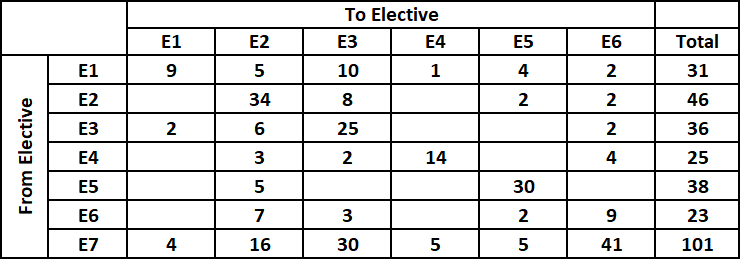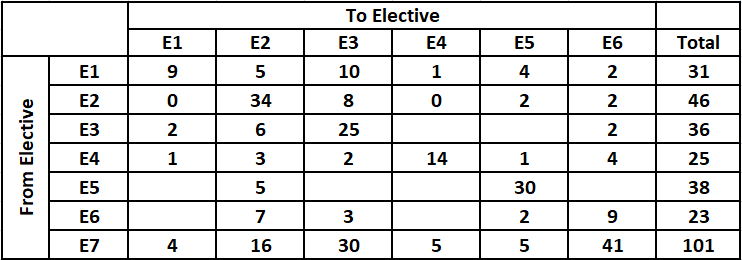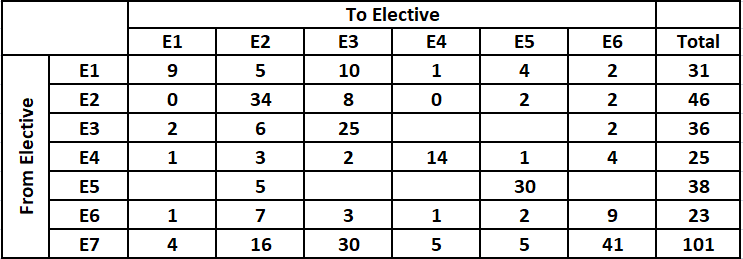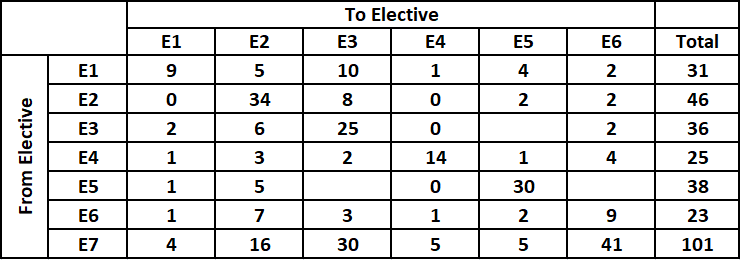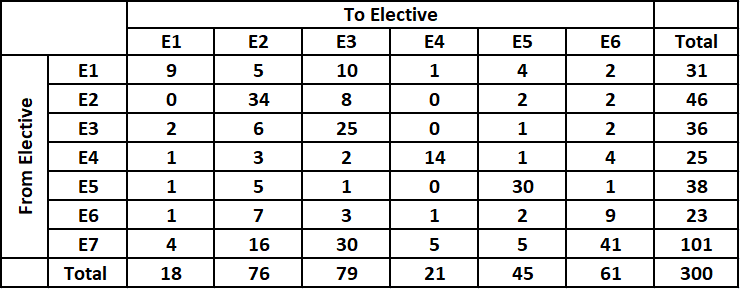CAT 2017 Slot 2 Question Paper
For the following questions answer them individually
CAT 2017 Slot 2 - Question 31
The five sentences (labelled 1, 2, 3, 4, 5) given in this question, when properly sequenced, form a coherent paragraph. Each sentence is labelled with a number. Decide on the proper order for the sentences and key in this sequence of five numbers as your answer.
1. Johnson treated English very practically, as a living language, with many different shades of meaning and adopted his definitions on the principle of English common law — according to precedent.
2. Masking a profound inner torment, Johnson found solace in compiling the words of a language that was, in its coarse complexity and comprehensive genius, the precise analogue of his character.
3. Samuel Johnson was a pioneer who raised common sense to heights of genius, and a man of robust popular instincts whose watchwords were clarity, precision and simplicity.
4. The 18th century English reader, in the new world of global trade and global warfare, needed a dictionary with authoritative acts of definition of words of a language that was becoming seeded throughout the first British empire by a vigorous and practical champion.
5. The Johnson who challenged Bishop Berkeley's solipsist theory of the nonexistence of matter by kicking a large stone ("I refute it thus") is the same Johnson for whom language must have a daily practical use.
789
456
123
0.-
Clear All
CAT 2017 Slot 2 - Question 32
Five sentences related to a topic are given below. Four of them can be put together to form a meaningful and coherent short paragraph. Identify the odd one out.
1. Although we are born with the gift of language, research shows that we are surprisingly unskilled when it comes to communicating with others.
2. We must carefully orchestrate our speech if we want to achieve our goals and bring our dreams to fruition.
3. We often choose our words without thought, oblivious of the emotional effects they can have on others.
4. We talk more than we need to, ignoring the effect we are having on those listening to us.
5. We listen poorly, without realizing it, and we often fail to pay attention to the subtle meanings conveyed by facial expressions, body gestures, and the tone and cadence of our voice.
789
456
123
0.-
Clear All
CAT 2017 Slot 2 - Question 33
Five sentences related to a topic are given below. Four of them can be put together to form a meaningful and coherent short paragraph. Identify the odd one out.
1: Over the past fortnight, one of its finest champions managed to pull off a similar impression.
2. Wimbledon's greatest illusion is the sense of timelessness it evokes.
3. At 35 years and 342 days, Roger Federer became the oldest man to win the singles title in the Open Era — a full 14 years after he first claimed the title as a scruffy, pony-tailed upstart.
4. Once he had survived the opening week, the second week witnessed the range of a rested Federer's genius.
5. Given that his method isn't reliant on explosive athleticism or muscular ball-striking, both vulnerable to decay, there is cause to believe that Federer will continue to enchant for a while longer.
789
456
123
0.-
Clear All
CAT 2017 Slot 2 - Question 34
Five sentences related to a topic are given below. Four of them can be put together to form a meaningful and coherent short paragraph. Identify the odd one out.
1. Those geometric symbols and aerodynamic swooshes are more than just skin deep.
2. The Commonwealth Bank logo — a yellow diamond, with a black chunk sliced out in one corner — is so recognisable that the bank doesn't even use its full name in its advertising.
3. It's not just logos with hidden shapes; sometimes brands will have meanings or stories within them that are deliberately vague or lost in time, urging you to delve deeper to solve the riddle.
4. Graphic designers embed cryptic references because it adds a story to the brand; they want people to spend more time with a brand and have that idea that they are an insider if they can understand the hidden message.
5. But the CommBank logo has more to it than meets the eye, as squirrelled away in that diamond is the Southern Cross constellation.
789
456
123
0.-
Clear All
Funky Pizzeria was required to supply pizzas to three different parties. The total number of pizzas it had to deliver was 800, 70% of which were to be delivered to Party 3 and the rest equally divided between Party 1 and Party 2.
Pizzas could be of Thin Crust (T) or Deep Dish (D) variety and come in either Normal Cheese (NC) or Extra Cheese (EC) versions. Hence, there are four types of pizzas: T-NC, T-EC, D-NC and D-EC. Partial information about proportions of T and NC pizzas ordered by the three parties is given below:

CAT 2017 Slot 2 - Question 35
How many Thin Crust pizzas were to be delivered to Party 3?
CAT 2017 Slot 2 - Question 36
How many Normal Cheese pizzas were required to be delivered to Party 1?
CAT 2017 Slot 2 - Question 37
For Party 2, if 50% of the Normal Cheese pizzas were of Thin Crust variety, what was the difference between the numbers of T-EC and D-EC pizzas to be delivered to Party 2?
CAT 2017 Slot 2 - Question 38
Suppose that a T-NC pizza cost as much as a D-NC pizza, but 3/5th of the price of a D-EC pizza.A D-EC pizza costs Rs. 50 more than a T-EC pizza, and the latter costs Rs. 500.
If 25% of the Normal Cheese pizzas delivered to Party 1 were of Deep Dish variety, what was the total bill for Party 1?
There were seven elective courses - E1 to E7 - running in a specific term in a college. Each of the 300 students enrolled had chosen just one elective from among these seven. However, before the start of the term, E7 was withdrawn as the instructor concerned had left the college. The students who had opted for E7 were allowed to join any of the remaining electives. Also, the students who had chosen other electives were given one chance to change their choice. The table below captures the movement of the students from one elective to another during this process. Movement from one elective to the same elective simply means no movement. Some numbers in the table got accidentally erased; however, it is known that these were either 0 or 1.
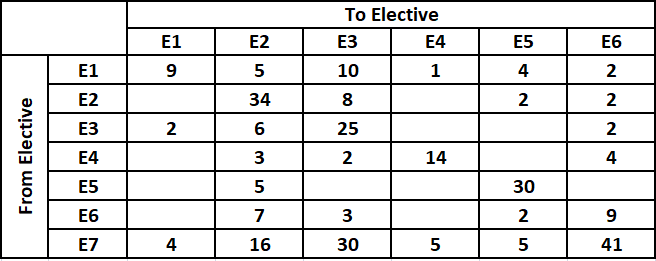
Further, the following are known:
1. Before the change process there were 6 more students in E1 than in E4, but after the reshuffle, the number of students in E4 was 3 more than that in E1.
2. The number of students in E2 increased by 30 after the change process.
3. Before the change process, E4 had 2 more students than E6, while E2 had 10 more students than E3.
CAT 2017 Slot 2 - Question 39
How many elective courses among E1 to E6 had a decrease in their enrollments after the change process?
CAT 2017 Slot 2 - Question 40
After the change process, which of the following is the correct sequence of number of students in the six electives E 1 to E6?






